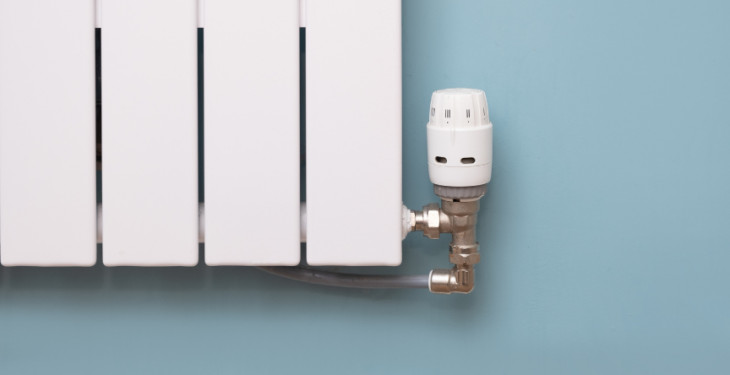

Written by Stephen Day
Gas Safe Engineer
Updated: 30th May, 2025
As the colder months are beginning to set in, you may want to increase the temperatures emitted from your properties radiators, but are worried this may further run up your heating bill in these record breaking times for energy costs.
As the colder months are beginning to set in, you may want to increase the temperatures emitted from your properties radiators, but are worried this may further run up your heating bill in these record breaking times for energy costs.
Fear not, through the implementation of Thermostatic Radiator Valves you can keep your home warm and toasty when you need, without breaking the bank.
Get a quote in 60 seconds, fitted as fast as next day!
0% APR finance available.
Despite its technical sounding name, a Thermostatic Radiator Valve or TRV, is a simple but very effective method of controlling room temperature.
A TRV is a self-regulating valve fitted to a radiator to control its flow of incoming hot water, and the subsequent temperature it radiates.

A TRV is made up of two parts, the head and the body, upon its detection of a temperature change within a room, a capsule in the valve head either contracts or expands.
If the room becomes warmer than the pre-set ideal temperature, expansion of an internal capsule will cause a pin to move and close the valve, thus slowing the influx of hot water into the radiator, maintaining the ideal temperature rather than continuing to increase it.
If the room becomes too cold, the reverse mechanism occurs, the contraction of the valve head capsule pulls the pin back out, reallowing the increased flow of hot water into the system again.
This is considered more accurate and efficient as it removes the task of manually opening and closing a traditional radiator valve to adjust the temperature.
There are two popular materials that the TRV capsule is usually made of, liquid or wax. Generally, liquid capsules tend to be more prevalent due to their greater responsiveness to temperature changes, a crucial step in the functionality of a TRV.
It’s no secret that the current cost of living crisis in the UK is a volatile topical issue, with energy bills soaring amid the second consecutive record breaking energy price cap announced recently by Ofgem.
As the colder months begin to set in (traditionally the period in which consumers use the most heat energy), any relief from these costs without sacrificing a comfortable temperature for your property, would constitute a smart choice.
TVRs can help cut down a property's energy bills by more efficiently heating your home, this is called zonal heating.
Through Thermostatic Radiator Valves you can heat different rooms within your home at different times, meaning there is no unnecessary heat loss for unoccupied rooms.
Also TRVs as mentioned above, actively control the influx of hot water for the radiators in high traffic rooms, meaning the room does not become too hot.

If you want to further increase the efficiency of your radiator system, smart TVRs can be controlled remotely for constant temperature regulation via a smart thermostat or app.
As with the price of any heat regulating component, costs for TRVs can vary depending on model, quantity and merchant rates. Generally the price range for a TRV is £10-£30.
However, it is worth noting for maximum TRV efficiency, the radiator must be first drained and cleaned via a Power flush or Chemical Flush to remove any dirt, sludge or potential debris build up.
These additional steps can cost into the hundreds, but with any iHeat boiler installation we offer a free chemical flush at no extra charge. A system flush will contribute to your overall system efficiency and help you save money on your heating long term.
In certain rooms around the house Thermostatic Radiator Valves may be less efficient for a variety of reasons.
The bathroom for example, this room would not be an ideal for a TRV due to the heat from the shower or bath tricking the TRV into shutting off the radiator, when in reality the heat generated would help control condensation.
Also it may not be beneficial to have a TVR in the same room as your main thermostat as they will cross sync with the boiler, causing erratic temperature control and a possible heat shutting off for your entire home.
If you want the most efficient heating system possible for your home, you should consider the efficiency of your current boiler.
At iHeat we stock a huge range of sleek new combi and system boilers, in a variety of power outputs as designed by internationally recognised and celebrated manufacturers.
With a free online quote, a price match guarantee and next day installation available, now might be the time to upgrade your heating system just in time for winter!
Get a quote in 60 seconds, fitted as fast as next day!
0% APR finance available.
Last updated: 30th May, 2025

Written by Stephen Day
Gas Safe Engineer at iHeat
Stephen Day is a Gas Safe registered and FGAS certified engineer with over 20 years of hands-on experience in the heating, cooling, and renewable energy industry, specialising in boiler installations, air conditioning, and heat pump systems.
LinkedInArticles by Stephen Day are reviewed by iHeat’s technical team to ensure accuracy and reliability.

22nd December, 2025
Based on data from over 7000 boiler installations completed by iHeat in the past 12 months...
 Read Article
Read Article

22nd December, 2025
Here’s a quick roundup of the best combi boilers for 2026.
 Read Article
Read Article

22nd December, 2025
When your old boiler breaks down and it comes time to replace it with a new one, it might...
 Read Article
Read Article
No obligation. Takes less than 60 seconds.